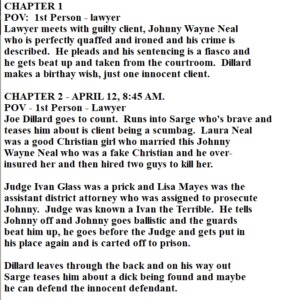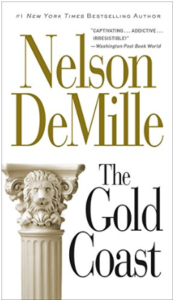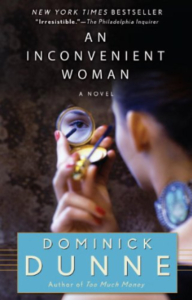REVERSE ENGINEERING BOOKS AS A SELF-LEARNING METHOD:
 The one area on YouTube that I never found any ‘work flow’ videos on was the method of reverse engineering story in order to learn the craft. I reread two or three of my favorite novels and reversed engineered them myself. I wanted to see what this method would teach me in terms of how these favorite stories fell into these novel format templates I was finding.
The one area on YouTube that I never found any ‘work flow’ videos on was the method of reverse engineering story in order to learn the craft. I reread two or three of my favorite novels and reversed engineered them myself. I wanted to see what this method would teach me in terms of how these favorite stories fell into these novel format templates I was finding.
I had trouble, and still have trouble understanding what a first plot point is compared to a second plot point, or the mid-story point. If your story is about someone setting off on an actual journey or adventure, I think it is easy to fit this plot line onto these templates, but if you story is a slice of life backdrop with a mystery and romance, it was harder for me to see how this all fit into these templates.
This dilemma is what led me to reverse engineer a few of my favorite books.
WHY WOULD YOU REVERSE ENGINEER A STORY?
My purpose in reverse engineering the stories was to find out how these stories fit into these template structures. I wanted more clarity in identifying various plot points and pinch points and how that was different from the mid-point. That was my only purpose when I took on this task.
HOW DID YOU DO THE REVERSE ENGINEERING?
 I re-read the book, and during and after each chapter, I wrote down what happened and where I thought this fit in the template. I also tried to identify the conflicts and obstacles, and anything else I thought was relevant to the story.
I re-read the book, and during and after each chapter, I wrote down what happened and where I thought this fit in the template. I also tried to identify the conflicts and obstacles, and anything else I thought was relevant to the story.
Having done this a few times now, I believe it is easier to do the reverse engineering with a book you have already read so you can read for structural understanding instead of trying to understand the story. It is also easier if you choose a book you enjoyed. You will enjoy it even more as you begin to see how the author structured the books and laid out the clues, etc.
WHAT DID YOU LEARN FROM REVERSE ENGINEERING A BOOK?
What I learned from the process was different from what I thought I would learn. First of all, I found the stories I liked didn’t really fit into these “journey format templates” either. I could identify the resistance to the call to action, the call to action itself, and the setbacks. I still couldn’t tell you which was was a plot point or a pinch point, even to this day and I’ve been at it now for three years, which is not that long, but I want to be honest. The clarity I got from this process was not what I had set out for.
What I did end up learning was that I picked up so much more from the story than I did the first time I read the story. The act of recording a summary after each chapter added a layer of understanding that allowed me to enjoy the books even more.
I also learned that “conflict” didn’t have to be a huge hostility between characters, it could be a sore spot, or a difference of opinion, conflict can be of the subtle kind. This freed me to understand that small deep inner conflicts were enough to write into the story. This was important because I don’t enjoy stories with these abrasive and brash personalities at play. I don’t like these people in real life and I don’t like them any more in print. So that was a big eye opener.
The other thing I learned was that as a newbie, I had to operate on the premise that I was only able to identify the inciting incident, call to action, refusal of the call to action, the circumstances that changed the call to action from a choice to almost a moral obligation. This would have to do until I got more experience under my belt.
But I noticed in my reverse engineering that in the long mid-act of the book, it is important to never led the book lag. So in lieu of operating with the pinch points and plot points, I focused on making each chapter have a purpose, drop some clues, and have some level of character development going on. This way, I figured the story was always moving and going forward. Only time will tell if this is enough.
WHAT IS THE REVERSE ENGINEERING OF A BOOK PROCESS?
For those of you who want a real how-to, I opened the books from Amazon.com on my computer and I had a notepad document opened and I put the summary for each chapter under the Chapter heading, so that after it was done, I could see this outline on the one document. Then I printed it and tried to figure out the plot points, pinch points, etc. Again, like I said earlier, the plot points and pinch points still evade me, but I was able to learn how the author laid out the clues and kept the story moving. I may have a blind spot regarding this plot point vs. pinch point because I am new to this, or it hasn't sunk in yet. If you have any tricks or tips you want to share about recognizing these in writing, please let me know and I can feature you in a blog post coming up!
FOR THE CURIOUS:

 The books I reverse engineered were The Gold Coast by Nelson DeMille and An Inconvenient Woman by Dominick Dunne I would recommend both of these writers and both of these books! They are linked with my associate links to the left or above.
The books I reverse engineered were The Gold Coast by Nelson DeMille and An Inconvenient Woman by Dominick Dunne I would recommend both of these writers and both of these books! They are linked with my associate links to the left or above.
